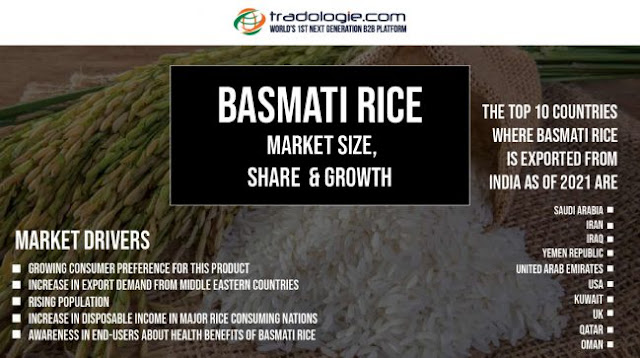Basmati Rice: Market Size, Share & Growth
Basmati is long and slender grained aromatic rice that is delicious in taste. It becomes fluffy and twice its original size once it is cooked. It is grown in the foothills of the Himalayas in India and Pakistan with India producing two-thirds of the total global supply. As of now, it is the staple of many Indian dishes and is also enjoyed as part of delectable cuisines across the world.
Basmati is high in carbohydrates and micronutrients such as folate, selenium and thiamine. It has a low glycemic index (GI) as compared to other rice varieties and is therefore good for people with diabetes. It is a whole grain and is associated with lowered risk of heart disease. It also mitigates the risk of high blood pressure and hypertension. No wonder many end-users are looking today for Basmati rice online and there is a potentially growing market waiting to be tapped.
Global Basmati Rice Market:
The global rice market is expected to register a positive growth trajectory boosted by factors such as rising demand for long-grained rice and a strong supply chain. Suppliers wanting to export rice now have many options to get started.
The cost of this variety is higher than the other varieties of rice and this can be an impediment to its growing adoption. However, positive factors such as a steady increase in consumer purchasing power worldwide and recognition of the awesome taste of this rice are working to facilitate trade in its favor. Moreover, governments in many countries are taking steps to strengthen the basmati rice supply chain, thereby streamlining the import and export of Basmati rice.
India is the largest producer and exporter of Basmati rice. The major states within India where it is grown include Haryana, Himachal Pradesh, Uttarakhand, Uttar Pradesh, Jammu and Kashmir, and Delhi. The global rice market is expected to register a CAGR of 0.88 percent during the period of 2019-2024. There is a growing demand for rice globally and this is having a positive impact on the Basmati rice market as well.
The Middle East and Africa are the major consumers of this rice variety. The GCC countries are the largest importers of the paddy crop from India and Pakistan. The steady rise in imports from Saudi Arabia and Iran is leading to a growth in the exports of the crop from India. The major importers from Africa are Algeria, Somalia, and Kenya. There is also a steady demand from Europe and the USA.
Market Drivers:
- Growing Consumer Preference for this product
- Increase in Export Demand from Middle Eastern countries
- Rising population
- Increase in disposable income in major rice consuming nations
- Awareness in end-users about health benefits of Basmati rice
The top 10 countries where Basmati Rice is exported from India as of 2021 are Saudi Arabia, Iran, Iraq, Yemen Republic, United Arab Emirates, USA, Kuwait, UK, Qatar, and Oman. India today is the leading basmati rice exporter; the country enjoys as much as 45 percent of the market share of export of rice at a global level.
Want to be a Basmati rice importer or exporter and need some assistance in getting started? Connect with Tradologie.com and know about a new way to trade in rice at the best possible price.
Original Source: https://blog.tradologie.com/basmati-rice-market-size-share-growth/




Comments
Post a Comment